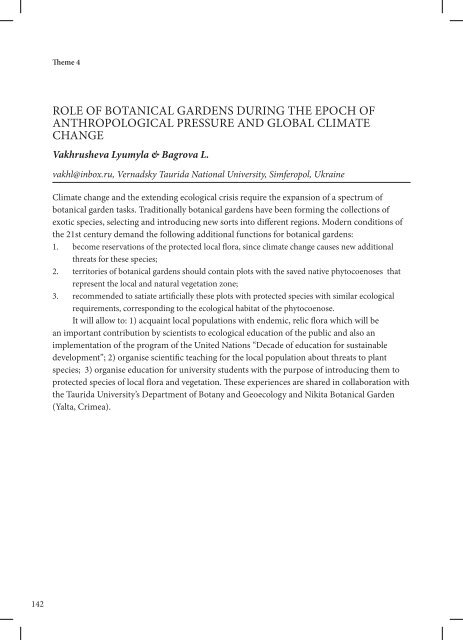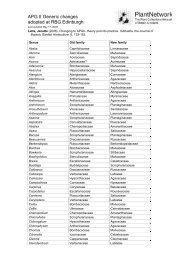Botanic gardens in the age of climate change - PlantNetwork
Botanic gardens in the age of climate change - PlantNetwork
Botanic gardens in the age of climate change - PlantNetwork
Create successful ePaper yourself
Turn your PDF publications into a flip-book with our unique Google optimized e-Paper software.
142<br />
Theme 4<br />
ROLE OF BOTANICAL GARDENS DURING THE EPOCH OF<br />
ANTHROPOLOGICAL PRESSURE AND GLOBAL CLIMATE<br />
CHANGE<br />
Vakhrusheva Lyumyla & Bagrova L.<br />
vakhl@<strong>in</strong>box.ru, Vernadsky Taurida National University, Simferopol, Ukra<strong>in</strong>e<br />
Climate <strong>change</strong> and <strong>the</strong> extend<strong>in</strong>g ecological crisis require <strong>the</strong> expansion <strong>of</strong> a spectrum <strong>of</strong><br />
botanical garden tasks. Traditionally botanical <strong>gardens</strong> have been form<strong>in</strong>g <strong>the</strong> collections <strong>of</strong><br />
exotic species, select<strong>in</strong>g and <strong>in</strong>troduc<strong>in</strong>g new sorts <strong>in</strong>to different regions. Modern conditions <strong>of</strong><br />
<strong>the</strong> 21st century demand <strong>the</strong> follow<strong>in</strong>g additional functions for botanical <strong>gardens</strong>:<br />
1. become reservations <strong>of</strong> <strong>the</strong> protected local flora, s<strong>in</strong>ce <strong>climate</strong> <strong>change</strong> causes new additional<br />
threats for <strong>the</strong>se species;<br />
2. territories <strong>of</strong> botanical <strong>gardens</strong> should conta<strong>in</strong> plots with <strong>the</strong> saved native phytocoenoses that<br />
represent <strong>the</strong> local and natural vegetation zone;<br />
3. recommended to satiate artificially <strong>the</strong>se plots with protected species with similar ecological<br />
requirements, correspond<strong>in</strong>g to <strong>the</strong> ecological habitat <strong>of</strong> <strong>the</strong> phytocoenose.<br />
It will allow to: 1) acqua<strong>in</strong>t local populations with endemic, relic flora which will be<br />
an important contribution by scientists to ecological education <strong>of</strong> <strong>the</strong> public and also an<br />
implementation <strong>of</strong> <strong>the</strong> program <strong>of</strong> <strong>the</strong> United Nations “Decade <strong>of</strong> education for susta<strong>in</strong>able<br />
development”; 2) organise scientific teach<strong>in</strong>g for <strong>the</strong> local population about threats to plant<br />
species; 3) organise education for university students with <strong>the</strong> purpose <strong>of</strong> <strong>in</strong>troduc<strong>in</strong>g <strong>the</strong>m to<br />
protected species <strong>of</strong> local flora and vegetation. These experiences are shared <strong>in</strong> collaboration with<br />
<strong>the</strong> Taurida University’s Department <strong>of</strong> Botany and Geoecology and Nikita <strong>Botanic</strong>al Garden<br />
(Yalta, Crimea).





